Pistia
Pistia is a genus of aquatic plant in the arum family, Araceae. The single species it comprises, Pistia stratiotes, is often called water cabbage, water lettuce, Nile cabbage, or shellflower. Its native distribution is uncertain, but probably pantropical; it was first discovered from the Nile near Lake Victoria in Africa. It is now present, either naturally or through human introduction, in nearly all tropical and subtropical fresh waterways and considered an invasive species as well as a mosquito breeding habitat. The genus name is derived from the Greek word πιστός (pistos), meaning "water," and refers to the aquatic nature of the plants.[4]
| Pistia | |
|---|---|
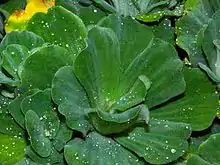 | |
| Scientific classification | |
| Kingdom: | Plantae |
| Clade: | Tracheophytes |
| Clade: | Angiosperms |
| Clade: | Monocots |
| Order: | Alismatales |
| Family: | Araceae |
| Subfamily: | Aroideae |
| Tribe: | Pistieae |
| Genus: | Pistia L.[1] |
| Species: | P. stratiotes |
| Binomial name | |
| Pistia stratiotes | |
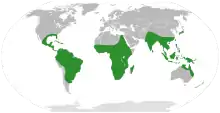 | |
| Range of the genus Pistia | |
| Synonyms[3] | |
| |
Description
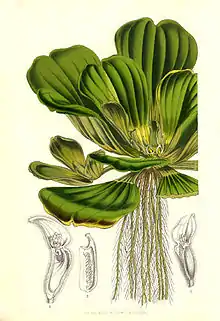
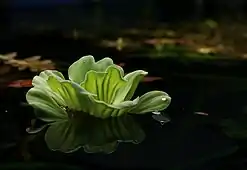
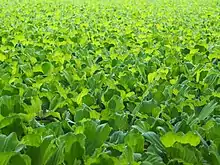
Pistia is a perennial monocotyledon with thick, soft leaves that form a rosette. It floats on the surface of the water, its roots hanging submersed beneath floating leaves. The leaves can be up to 14 cm long and have no stem. They are light green, with parallel veins, wavy margins and are covered in short hairs which form basket-like structures which trap air bubbles, increasing the plant's buoyancy. The flowers are dioecious, and are hidden in the middle of the plant amongst the leaves. Small green berries form after successful fertilization. The plant can also undergo asexual reproduction. Mother and daughter plants are connected by a short stolon, forming dense mats.
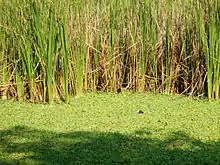
Ecology
Water lettuce is among the world's most productive freshwater aquatic plants and is considered an invasive species.[5] In waters with high nutrient content, particularly those that have been contaminated with human loading of sewage or fertilizers, water lettuce can often exhibit weedy overgrowth behavior. It may also become weedy in hydrologically altered systems such as canals and reservoirs.[6]
It is a common aquatic plant in the southeastern United States, particularly in Florida. It was first reported in Florida by the explorers John and William Bartram during the period 1765-1774, and a fossil specimen and fossil pollen that have been found in Florida date from the late Pleistocene (~12,000 BP) and early Holocene (~3,500 BP), indicating that Pistia is native to southeastern North America.[7][8]
Severe overgrowth of water lettuce can block gas exchange at the air-water interface, reducing the oxygen in the water and killing fish. Large mats can also block light, shade native submerged plants, and alter immersed plant communities by crushing them.[9]
Mosquitoes of the genus Mansonia complete their life cycle only in the presence of aquatic plants such as Pistia, laying their eggs under the leaves. The emerging larvae fall into the water within 24 hours and stay attached to the Pistia root (which is rich with air sacs) with the help of a serrated siphon tube for respiration and develop into pupa. The pupa is also attached to the pistia root with the serrated piercing siphon tube. The egg to adult mosquito development is completed within 7 days.[10]
The moth Samea multiplicalis also uses Pistia as its primary host plant. Eggs are laid among leaves and stems of the host plant and larvae hatch and feed intensively as they develop.[11]
Control
Pistia can be controlled by mechanical harvesters that remove the water lettuce from the water and transport it to disposal on shore. Aquatic herbicides may also be used. Two species of insects are also being used as a biological control. Adults and larvae of the South American weevil Neohydronomous affinis feed on Pistia leaves, as do the larvae of the moth Spodoptera pectinicornis from Thailand. Both are proving to be useful tools in the management of Pistia.
In the Amazon basin, Pistia is a food source of freshwater turtles.[12]
Native range
The center of origin of Pistia stratiotes is uncertain. It has been found in the fossil record throughout much of the world. Although it is depicted in Egyptian hieroglyphics and the ancient Greek botanists Dioscorides and Theophrastus described it from the Nile River, suggesting an African origin, it hosts many co-evolved specialist insect herbivores in Brazil and Argentina, suggesting the possibility of a South American origin.[13] The claim that Pistia is not native to Florida and the southeastern United States is controversial.[7]
Fossil record
Pistia-like plants appear in the fossil record during the Late Cretaceous epoch in rock strata from the western interior of North America. They were first described as †Pistia corrugata by Leo Lesquereux in 1876 based on specimens from the Almond Formation of Wyoming (late Campanian age). However, based on more complete specimens from the Campanian Dinosaur Park Formation of southern Alberta, Canada, and other areas, they were redescribed as a separate genus, †Cobbania, primarily due to differences in leaf morphology.[14][15] Younger fossils attributed to Pistia have described from Eocene strata in the southeastern United States,[7] and 350 fossil seeds of †Pistia sibirica have been described from middle Miocene strata of the Fasterholt area near Silkeborg in Central Jutland, Denmark. Fossils of this species have also been described from the Oligocene and Miocene of Western Siberia and from the Miocene of Germany.[16]
A specimen of Pistia from the Florida peninsula dating from at least 3,550 years Before Present, as well as a report of early Holocene Pistia pollen from a lake in Florida, have cast doubt on the claim that Pistia is not native to the southeastern United States.[7][8]
Uses
Water lettuce is often used in tropical aquariums to provide cover for fry and small fish. It is also helpful as it outcompetes algae for nutrients in the water, thereby preventing massive algal blooms.
References
| Wikispecies has information related to Pistia stratiotes. |
- "Genus: Pistia L". Germplasm Resources Information Network. United States Department of Agriculture. 2006-02-23. Archived from the original on 2012-09-15. Retrieved 2011-09-30.
- "Pistia stratiotes". Germplasm Resources Information Network (GRIN). Agricultural Research Service (ARS), United States Department of Agriculture (USDA). Retrieved 2011-09-30.
- "World Checklist of Selected Plant Families: Royal Botanic Gardens, Kew". wcsp.science.kew.org.
- Quattrocchi, Umberto (2000). CRC World Dictionary of Plant Names. Volume III: M-Q. CRC Press. p. 2084. ISBN 978-0-8493-2677-6.
- Muniappan, Rangaswamy; Reddy, Gadi; Raman, Anantanarayanan (2009). Biological Control of Tropical Weeds Using Arthropods. Cambridge University Press. pp. 332–352. doi:10.1017/CBO9780511576348.017. ISBN 9780511576348.
- Kasulo, V. 2000. The impact of invasive species in African lakes. In: The economics of biological invasions (eds. C. Perrings, M. Williamson and S. Dalmozzone). Pp. 183-207. Cheltenham, UK: Edward Elgar.
- Evans, Jason M. (July 1, 2013). "Pistia stratiotes L. in the Florida Peninsula: Biogeographic Evidence and Conservation Implications of Native Tenure for an 'Invasive' Aquatic Plant". Conservation and Society. 11 (3): 233. doi:10.4103/0972-4923.121026 – via www.conservationandsociety.org.
- Berry, E.W. 1917 (1917). "The fossil plants from Vero, Florida". The Journal of Geology. 25 (7): 661–666. Bibcode:1917JG.....25..661B. doi:10.1086/622533. JSTOR 30062509. S2CID 128893139.
- Ramey, Victor (2001). "Water Lettuce (Pistia stratiotes)". Center for Aquatic and Invasive Plants, University of Florida. Retrieved 26 April 2010.
- Park, K (2007). Parks Text Book of Preventive and Social Medicine (19th ed.). Jabalpur India.
- Wheeler, G.S; Halpern, M.D (1999). "Compensatory responses of Samea multiplicalis larvae when fed leaves of different fertilization levels of the aquatic weed Pistia stratiotes". Entomologia Experimentalis et Applicata. 92 (2): 205–216. doi:10.1046/j.1570-7458.1999.00539.x. S2CID 84780873.
- Salo, Matti; Sirén, Anders; Kalliola, Risto (20 November 2013). Diagnosing Wild Species Harvest: Resource Use and Conservation. Academic Press. p. 115. ISBN 978-0-12-397755-7. Retrieved 27 January 2016.
- Laboratory, NOAA Great Lakes Environmental Research. "NOAA National Center for Research on Aquatic Invasive Species (NCRAIS)". nas.er.usgs.gov.
- Stockey, R.A., Rothwell, G.R. and Johnson, K.R. 2007. Cobbania corrugata gen. et comb. nov. (Araceae): A floating aquatic monocot from the Upper Cretaceous of western North America. American Journal of Botany, vol. 94, no. 4, p. 609-624.
- Stockey, R.A., Rothwell, G.R. and Johnson, K.R. 2016. Evaluating relationships among floating aquatic monocots: A new species of Cobbania (Araceae) from the Upper Maastrichtian of South Dakota. International Journal of Plant Sciences, vol. 177, no. 8, p. 706-725.
- Angiosperm Fruits and Seeds from the Middle Miocene of Jutland (Denmark) by Else Marie Friis, The Royal Danish Academy of Sciences and Letters 24:3, 1985
External links
 Media related to Pistia at Wikimedia Commons
Media related to Pistia at Wikimedia Commons- Centre for Aquatic and Invasive Plants
- Pistia stratiotes information from the Hawaiian Ecosystems at Risk project (HEAR)
- Species Profile- Water Lettuce (Pistia stratiotes), National Invasive Species Information Center, United States National Agricultural Library. Lists general information and resources for Water Lettuce.
